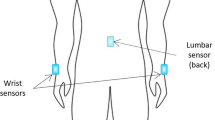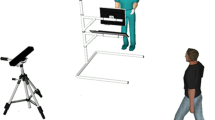Abstract
Millions of people worldwide are affected by Parkinson’s disease (PD), which significantly worsens their quality of life. Currently, the diagnosis is based on assessment of motor symptoms, but interest toward non-motor symptoms is increasing, as well. Among them, idiopathic hyposmia (IH) is associated with an increased risk of developing PD in healthy adults. In this work, a wearable inertial device, named SensFoot V2, was used to acquire motor data from 30 healthy subjects, 30 people with IH, and 30 PD patients while performing tasks from the MDS-UPDRS III for lower limb assessment. The most significant and non-correlated extracted parameters were selected in a feature array that can identify differences between the three groups of people. A comparative classification analysis was performed by applying three supervised machine learning algorithms. The system resulted able to distinguish between healthy and patients (specificity and recall equal to 0.967), and the people with IH can be identified as a separate class within a three-group classification (accuracy equal to 0.78). Thus, the system could support the clinician in objective assessment of PD. Further, identification of IH together with changes in motor parameters could be a non-invasive two-step approach to investigate the early onset of PD.




Similar content being viewed by others
References
Al-Aidaroos, K. M., A. Abu Bakar, and Z. Othman. Naïve Bayes variants in classification learning. Proc.—2010 Int. Conf. Inf. Retr. Knowl. Manag. Explor. Invis. World, CAMP’10 276–281, 2010. https://doi.org/10.1109/infrkm.2010.5466902.
Alam, M. N., A. Garg, T. T. K. Munia, R. Fazel-Rezai, and K. Tavakolian. Vertical ground reaction force marker for Parkinson’s disease. PLoS ONE 12:1–13, 2017.
Antonini, A., R. Benti, S. De Notaris, S. Tesei, A. Zecchinelli, G. Sacilotto, N. Meucci, M. Canesi, C. Mariani, G. Pezzoli, et al. 123I-Ioflupane/SPECT binding to striatal dopamine transporter (DAT) uptake in patients with Parkinson’s disease, multiple system atrophy, and progressive supranuclear palsy. Neurol. Sci. 24:149–150, 2003.
Arora, S., V. Venkataraman, S. Donohue, K. M. Biglan, E. R. Dorsey, and M. A. Little. High accuracy discrimination of Parkinson’s disease participants from healthy controls using smartphones. Acoust. Speech Signal Process. 2014. https://doi.org/10.1109/icassp.2014.6854280.
Atkinson-Clement, C., S. Pinto, A. Eusebio, and O. Coulon. Diffusion tensor imaging in Parkinson’s disease: review and meta-analysis. NeuroImage Clin. 16:98–110, 2017.
Barth, J., J. Klucken, P. Kugler, T. Kammerer, R. Steidl, J. Winkler, J. Hornegger, and B. Eskofier. Biometric and mobile gait analysis for early diagnosis and therapy monitoring in Parkinson’s Disease. Eng. Med. Biol. Soc. 2011. https://doi.org/10.1109/IEMBS.2011.6090226.
Berg, D., A. E. Lang, R. B. Postuma, W. Maetzler, G. Deuschl, T. Gasser, A. Siderowf, A. H. Schapira, W. Oertel, J. A. Obeso, C. W. Olanow, W. Poewe, and M. Stern. Changing the research criteria for the diagnosis of Parkinson’s disease: obstacles and opportunities. Lancet Neurol. 12:514–524, 2013.
Breiman, L. Random Forest. Mach. Learn. 45:5–32, 2001.
Burges, C. J. C. A tutorial on support vector machines for pattern recognition. Data Min. Knowl. Discov. 2:121–167, 1998.
Dorsey, E. R., R. Constantinescu, J. P. Thompson, K. M. Biglan, R. G. Holloway, K. Kieburtz, F. J. Marshall, B. M. Ravina, G. Schifitto, A. Siderowf, and C. M. Tanner. Projected number of people with Parkinson disease in the most populous nations, 2005 through 2030. Neurology 68(5):384–386, 2007.
Fahn, S. Clinical aspects of Parkinson disease. In: Parkinson’s disease: molecular and therapeutic insights from model systems, edited by R. Nass, and S. Przedborski. Amsterdam: Elsevier Inc., 2008, pp. 3–48.
Galantucci, S., F. Agosta, E. Stefanova, S. Basaia, M. P. Van Den Heuvel, T. Stojković, E. Canu, I. Stanković, V. Spica, M. Copetti, et al. Structural brain connectome and cognitive impairment in Parkinson disease. Radiology 283:515–525, 2016.
Gelb, D. J., E. Oliver, and S. Gilman. Criteria for the diagnosis of Parkinson’s Disease. Arch. Neurol. 56:33–39, 1999.
Gislason, P. O., J. A. Benediktsson, and J. R. Sveinsson. Random forests for land cover classification. Pattern Recognit. Lett. 27:294–300, 2006.
Goetz, C. G., B. C. Tilley, S. R. Shaftman, G. T. Stebbins, S. Fahn, P. Martinez-Martin, W. Poewe, C. Sampaio, M. Stern, R. Dodel, B. Dubois, R. G. Holloway, J. Jankovic, J. Kulisevsky, A. E. Lang, A. J. Lees, S. Leurgans, P. A. LeWitt, D. Nyenhuis, C. W. Olanow, O. Rascol, A. Schrag, J. A. Teresi, J. J. van Hilten, and N. LaPelle. Movement disorder society-sponsored revision of the unified Parkinson’s disease rating scale (MDS-UPDRS): scale presentation and clinimetric testing results. Mov. Disord. 23:2129–2170, 2008.
Haugen, J., M. L. T. M. Muller, V. Kotagal, R. L. Albin, R. A. Koeppe, P. J. H. Scott, K. A. Frey, and N. I. Bohnen. Prevalence of impaired odor identification in Parkinson disease with imaging evidence of nigrostriatal denervation. J. Neural Transm. 123:421–424, 2016.
Hoehn, M. M., and M. D. Yahr. Parkinsonism: onset, progression, and mortality. Neurology 17:427–442, 1967.
Khorasani, A., and M. R. Daliri. HMM for Classification of Parkinson’s Disease based on the raw gait data. J. Med. Syst. 38:147, 2014.
Kim, J., B. S. Kim, and S. Savarese. Comparing image classification methods: K-nearest-neighbor and support-vector-machines. Stevens Point: World Scientific and Engineering Academy and Society (WSEAS), pp. 133–138, 2012.
Kim, J.-W., Y. Kwon, Y.-M. Kim, H.-Y. Chung, G.-M. Eom, J.-H. Jun, J.-W. Lee, S.-B. Koh, B. K. Park, and D.-K. Kwon. Analysis of lower limb bradykinesia in Parkinson’s disease patients. Geriatr. Gerontol. Int. 12:257–264, 2012.
Kugler, P., and C. Jaremenko. Automatic recognition of Parkinson’s disease using surface electromyography during standardized gait tests. Eng. Med. Biol. Soc. 2013. https://doi.org/10.1109/EMBC.2013.6610865.
Maremmani, C., F. Cavallo, C. Purcaro, G. Rossi, S. Salvadori, E. Rovini, D. Esposito, A. Pieroni, S. Ramat, P. Vanni, B. Fattori, and G. Meco. Combining olfactory test and motion analysis sensors in Parkinson’s disease preclinical diagnosis: a pilot study. Acta Neurol. Scand. 137:204–211, 2018.
Maremmani, C., G. Rossi, N. Tambasco, B. Fattori, A. Pieroni, S. Ramat, A. Napolitano, P. Vanni, P. Serra, P. Piersanti, M. Zanetti, M. Coltelli, M. Orsini, R. Marconi, C. Purcaro, A. Rossi, P. Calabresi, and G. Meco. The validity and reliability of the Italian olfactory identification test (IOIT) in healthy subjects and in Parkinson’s disease patients. Parkinsonism Relat. Disord. 18:788–793, 2012.
Palma, J.-A., and H. Kaufmann. Autonomic disorders predicting Parkinson disease. Parkinsonism Relat. Disord. 20:S94–S98, 2014.
Palmerini, L., S. Mellone, G. Avanzolini, F. Valzania, and L. Chiari. Quantification of motor impairment in Parkinson’s disease using an instrumented timed up and go test. IEEE Trans. Neural Syst. Rehabil. Eng. 21:664–673, 2013.
Patel, S., K. Lorincz, R. Hughes, N. Huggins, J. Growdon, D. Standaert, M. Akay, J. Dy, M. Welsh, and P. Bonato. Monitoring motor fluctuations in patients with Parkinson’s disease using wearable sensors. IEEE Trans. Inf. Technol. Biomed. 13:864–873, 2009.
Perumal, S. V., and R. Sankar. Gait and tremor assessment for patients with Parkinson’s disease using wearable sensors. ICT Express 2:168–174, 2016.
Ponsen, M. M., D. Stoffers, E. C. Wolters, J. Booij, and H. W. Berendse. Olfactory testing combined with dopamine transporter imaging as a method to detect prodromal Parkinson’s disease. J. Neurol. Neurosurg. Psychiatry 81:396–399, 2010.
Rigas, G., A. T. Tzallas, M. G. Tsipouras, P. Bougia, E. E. Tripoliti, D. Baga, D. I. Fotiadis, S. G. Tsouli, and S. Konitsiotis. Assessment of tremor activity in the Parkinson’s Disease using a set of wearable sensors. IEEE Trans. Inf. Technol. Biomed. 16:478–487, 2012.
Rovini, E., C. Maremmani, and F. Cavallo. How wearable sensors can support Parkinson’s disease diagnosis and treatment: a systematic review. Front. Neurosci. 11:555, 2017.
Sarkar, S., J. Raymick, and S. Imam. Neuroprotective and therapeutic strategies against Parkinson’s disease: recent perspectives. Int. J. Mol. Sci. 17(6):904, 2016.
Schapira, A. H., R. K. Chauduri, and P. Jenner. Non-motor features of Parkinson disease. Nat. Rev. Neurosci. 18:435–450, 2017.
Tien, I., S. D. Glaser, and M. J. Aminoff. Characterization of gait abnormalities in Parkinson’s disease using a wireless inertial sensor system. Eng. Med. Biol. Soc. 2010. https://doi.org/10.1109/IEMBS.2010.5627904.
Wahid, F., R. K. Begg, C. J. Hass, S. Halgamuge, and D. C. Ackland. Classification of Parkinson’s disease gait using spatial-temporal gait features. IEEE J. Biomed. Health Inform. 19:1794–1802, 2015.
Yan, K. YAN-PRTools., 2016. https://it.mathworks.com/matlabcentral/fileexchange/56723-yan-prtools.
Yang, K., W.-X. Xiong, F.-T. Liu, Y.-M. Sun, S. Luo, Z.-T. Ding, J.-J. Wu, and J. Wang. Objective and quantitative assessment of motor function in Parkinson’s disease—from the perspective of practical applications. Ann. Transl. Med. 4:90, 2016.
Acknowledgments
This work was financially supported by DAPHNE project (Regione Toscana PAR FAS 2007-2013, Bando FAS SALUTE 2014, CUP J52I16000170002).
Author information
Authors and Affiliations
Corresponding author
Additional information
Associate Editor Andreas Anayiotos oversaw the review of this article.
Electronic supplementary material
Below is the link to the electronic supplementary material.
Rights and permissions
About this article
Cite this article
Rovini, E., Maremmani, C., Moschetti, A. et al. Comparative Motor Pre-clinical Assessment in Parkinson’s Disease Using Supervised Machine Learning Approaches. Ann Biomed Eng 46, 2057–2068 (2018). https://doi.org/10.1007/s10439-018-2104-9
Received:
Accepted:
Published:
Issue Date:
DOI: https://doi.org/10.1007/s10439-018-2104-9




